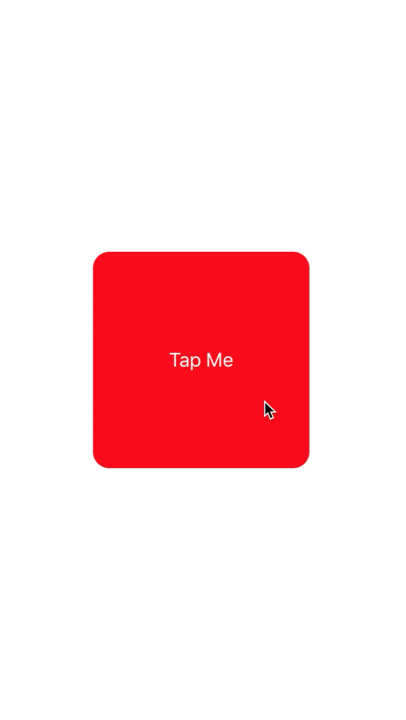iOS UIKit Dynamics Map Dynamic Animation Position Changes to Bounds
Example
This example shows how to customize the UIDynamicItem protocol to map position changes of a view being dynamically animated to bounds changes to create a UIButton that expands and contracts in a elastic fashion.
To start we need to create a new protocol that implements UIDynamicItem but that also has a settable and gettable bounds property.
Swift
protocol ResizableDynamicItem: UIDynamicItem
{
var bounds: CGRect { set get }
}
extension UIView: ResizableDynamicItem {}
Objective-C
@protocol ResizableDynamicItem <UIDynamicItem>
@property (nonatomic, readwrite) CGRect bounds;
@end
We'll then create a wrapper object that will wrap a UIDynamicItem but will map center changes to the item's width and height. We will also provide passthroughs for bounds and transform of the underlying item. This will cause any changes the dynamic animator makes to the center x and y values of the underlying item will be applied to the items width and height.
Swift
final class PositionToBoundsMapping: NSObject, UIDynamicItem
{
var target: ResizableDynamicItem
init(target: ResizableDynamicItem)
{
self.target = target
super.init()
}
var bounds: CGRect
{
get
{
return self.target.bounds
}
}
var center: CGPoint
{
get
{
return CGPoint(x: self.target.bounds.width, y: self.target.bounds.height)
}
set
{
self.target.bounds = CGRect(x: 0.0, y: 0.0, width: newValue.x, height: newValue.y)
}
}
var transform: CGAffineTransform
{
get
{
return self.target.transform
}
set
{
self.target.transform = newValue
}
}
}
Objective-C
@interface PositionToBoundsMapping ()
@property (nonatomic, strong) id<ResizableDynamicItem> target;
@end
@implementation PositionToBoundsMapping
- (instancetype)initWithTarget:(id<ResizableDynamicItem>)target
{
self = [super init];
if (self)
{
_target = target;
}
return self;
}
- (CGRect)bounds
{
return self.target.bounds;
}
- (CGPoint)center
{
return CGPointMake(self.target.bounds.size.width, self.target.bounds.size.height);
}
- (void)setCenter:(CGPoint)center
{
self.target.bounds = CGRectMake(0, 0, center.x, center.y);
}
- (CGAffineTransform)transform
{
return self.target.transform;
}
- (void)setTransform:(CGAffineTransform)transform
{
self.target.transform = transform;
}
@end
Finally, we'll create a UIViewController that will have a button. When the button is pressed we will create PositionToBoundsMapping with the button as the wrapped dynamic item. We create a UIAttachmentBehavior to it's current position then add an instantaneous UIPushBehavior to it. However because we have mapped changes its bounds, the button does not move but rather grows and shrinks.
Swift
final class ViewController: UIViewController
{
lazy var button: UIButton =
{
let button = UIButton(frame: CGRect(x: 0.0, y: 0.0, width: 300.0, height: 200.0))
button.backgroundColor = .red
button.layer.cornerRadius = 15.0
button.setTitle("Tap Me", for: .normal)
self.view.addSubview(button)
return button
}()
var buttonBounds = CGRect.zero
var animator: UIDynamicAnimator?
override func viewDidLoad()
{
super.viewDidLoad()
view.backgroundColor = .white
button.addTarget(self, action: #selector(self.didPressButton(sender:)), for: .touchUpInside)
buttonBounds = button.bounds
}
override func viewDidLayoutSubviews()
{
super.viewDidLayoutSubviews()
button.center = view.center
}
func didPressButton(sender: UIButton)
{
// Reset bounds so if button is press twice in a row, previous changes don't propogate
button.bounds = buttonBounds
let animator = UIDynamicAnimator(referenceView: view)
// Create mapping
let buttonBoundsDynamicItem = PositionToBoundsMapping(target: button)
// Add Attachment behavior
let attachmentBehavior = UIAttachmentBehavior(item: buttonBoundsDynamicItem, attachedToAnchor: buttonBoundsDynamicItem.center)
// Higher frequency faster oscillation
attachmentBehavior.frequency = 2.0
// Lower damping longer oscillation lasts
attachmentBehavior.damping = 0.1
animator.addBehavior(attachmentBehavior)
let pushBehavior = UIPushBehavior(items: [buttonBoundsDynamicItem], mode: .instantaneous)
// Change angle to determine how much height/ width should change 45° means heigh:width is 1:1
pushBehavior.angle = .pi / 4.0
// Larger magnitude means bigger change
pushBehavior.magnitude = 30.0
animator.addBehavior(pushBehavior)
pushBehavior.active = true
// Hold refrence so animator is not released
self.animator = animator
}
}
Objective-C
@interface ViewController ()
@property (nonatomic, strong) UIButton *button;
@property (nonatomic, assign) CGRect buttonBounds;
@property (nonatomic, strong) UIDynamicAnimator *animator;
@end
@implementation ViewController
- (void)viewDidLoad
{
[super viewDidLoad];
self.view.backgroundColor = [UIColor whiteColor];
[self.button addTarget:self action:@selector(didTapButton:) forControlEvents:UIControlEventTouchUpInside];
self.buttonBounds = self.button.bounds;
}
- (void)viewDidLayoutSubviews
{
[super viewDidLayoutSubviews];
self.button.center = self.view.center;
}
- (UIButton *)button
{
if (!_button)
{
_button = [[UIButton alloc]initWithFrame:CGRectMake(0.0, 0.0, 200.0, 200.0)];
_button.backgroundColor = [UIColor redColor];
_button.layer.cornerRadius = 15.0;
[_button setTitle:@"Tap Me" forState:UIControlStateNormal];
[self.view addSubview:_button];
}
return _button;
}
- (void)didTapButton:(id)sender
{
self.button.bounds = self.buttonBounds;
UIDynamicAnimator *animator = [[UIDynamicAnimator alloc] initWithReferenceView:self.view];
PositionToBoundsMapping *buttonBoundsDynamicItem = [[PositionToBoundsMapping alloc]initWithTarget:sender];
UIAttachmentBehavior *attachmentBehavior = [[UIAttachmentBehavior alloc]initWithItem:buttonBoundsDynamicItem attachedToAnchor:buttonBoundsDynamicItem.center];
[attachmentBehavior setFrequency:2.0];
[attachmentBehavior setDamping:0.3];
[animator addBehavior:attachmentBehavior];
UIPushBehavior *pushBehavior = [[UIPushBehavior alloc] initWithItems:@[buttonBoundsDynamicItem] mode:UIPushBehaviorModeInstantaneous];
pushBehavior.angle = M_PI_4;
pushBehavior.magnitude = 2.0;
[animator addBehavior:pushBehavior];
[pushBehavior setActive:TRUE];
self.animator = animator;
}
@end
For more information see UIKit Dynamics Catalog

